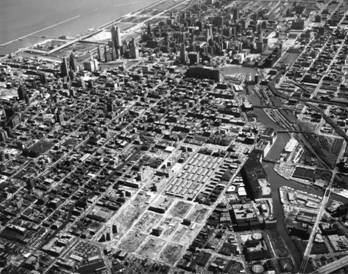
In 1937, President Franklin D. Roosevelt expressed his frustration at seeing “one third of a nation ill-housed, ill-clad, [and] ill-nourished.”
In the years leading up to FDR’s second term, twelve and a half million workers were unemployed, nine thousand banks closed (costing depositors 2.5 billion), and new home construction dropped 95 percent below the 1920s rate.
As a consequence, Roosevelt’s New Deal – the overarching name given to the numerous programs established during his administration to deal with the Great Depression – sought to tackle both housing and employment problems by attempting to provide housing assistance in a wide variety of ways. Although most of Roosevelt’s New Deal efforts were aimed at private development and programs to protect and assist homeowners through programs such as the Home Owners Loan Corporation (HOLC) and the Federal Housing Administration (FHA), the New Deal also included measures for affordable public housing for the working poor.
Chicago in the 1930's
Chicago, like many urban areas, was mired in a housing crisis. From 1930 to 1938, 18,221 units were demolished while only 7,619 new homes were built. The 10,602 unit deficit was exacerbated by the 60,517 families who moved to Chicago looking for work during the Great Depression. By 1937 the vacancy rate was a disastrous 2.1%. The city benefited from federal efforts, receiving grants and federally-guaranteed loans to build housing for low-income Chicagoans. The programs were unprecedented in the United States and reformers remained optimistic about empowering hard-working Americans.
Laying the Foundation for New Deal Public Housing
Though Americans living in the 1930s craved security, the Great Depression exposed the inadequacy of the current political and economic infrastructures to provide it. While the public suffered from the weak infrastructure, they were simultaneously apprehensive to change. Subsequently, New Dealers had an opportunity to make radical change in the political infrastructure, and take a more active role in dealing with economic inequality and racial injustice. In the precarious position of addressing a massive economic crisis with a public ambivalent about change, the New Deal achieved mixed results in its endeavors; housing was no exception.
Authorized under a section of the National Industrial Recovery Act of 1933 dealing, the Public Works Administration (PWA) created housing developments such as the Julia C. Lathrop Homes, Trumbull Park Homes, and Jane Addams Houses. Officials designed these complexes to address housing shortages and spur economic development in the depths of the Great Depression. The federal government directly administered PWA housing projects, but this approach would change in 1937. Under the Wagner Housing Act, the federal government created the United States Housing Authority (USHA) while simultaneously shifting control of public housing shifted to local communities. In Chicago that led to the establishment of the Chicago Housing Authority.
Why Study Public Housing in Chicago?
The rich history of public housing in Chicago makes it an excellent topic for Chicago Metro History Fair projects. Students researching public housing can investigate the human experience of poverty and inadequate housing, inquire into the Roosevelt Administration’s attempt to reconfigure the government to provide the basic need of housing, and evaluate the impact of public housing advocates’ visions and implementation.
While there are dozens of ways to approach the history of public housing and the Chicago Housing Authority (CHA), this essay will take a brief look at the political, social, and architectural histories of public housing in Chicago, and pose potential historical questions to aid students in developing a topic. The Center for New Deal Studies is committed to arming aspiring historians with the intellectual tools necessary to succeed in any project. As such, this essay will supplement information with a bibliography of sources accessible to Chicagoland students and strategies to approach the topic.
The essay will assist students with developing a research project on public housing in Chicago by focusing on the following three perspectives:
- Political History
Political histories of public housing examine the policies behind, and the politics surrounding, the establishment and implementation of this program. This approach, which is often more top-down, might focus, for example, on the political foundation for federally-subsidized public housing, and specifically, the obstacles public housing advocates faced when trying to implement their vision. - Social History
Social histories of public housing focus on the human experience, and often take a more bottom-up approach. Historians usually rely on the creative usage of primary sources to convey the experiences of ordinary people in the past. - Architecture
Architectural history concerns itself with the built environment. Blending social, political, and cultural history, it concentrates on the designs of the housing projects themselves, and analyzes how buildings reflect and foster particular communities, and therefore behaviors and values.
Resources for your project:
- Bibliography
- Newspaper Timeline
- National Public Housing Museum
- National Archives
- Chicago Public Library
- Roosevelt University Library
- Center for New Deal Studies Holdings
1. Franklin D. Roosevelt, “Second Inaugural Address” in Inaugural Addresses of the Presidents of the United States [book on-line] (Washington, D.C.: U.S. G.P.O., 1989,), available from http://www.bartleby.com/124/pres50.html (accessed 4 September 2007).
2. Statistics cited in David M. Kennedy, Freedom from Fear: The American People in Depression and War, 1929-1945 (New York: Oxford University Press. 2005), p. 368; and James L. Roark, et. al., The American Promise (Boston: Bedford St. Martins. 2007), p. 611.
3. Kennedy, Freedom from Fear, p. 369.
4. Chicago Housing Authority, “Report to the Mayor,” 1940, Chicago Public Library, Harold Washington Center, Municipal Records Collection, p. 7.